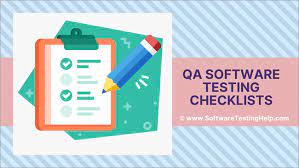In today’s world, web-based applications are the core of personal and business communication. It is therefore essential to ensure that your application is tested thoroughly prior to releasing it to the general public. But what can you do to ensure you’ve done everything right? Here’s a helpful checklist of QA actions to follow while testing your web-based application.
When you’ve spent the time and effort to create your website or web-based application, you’ll want to ensure that it’s free of bugs and performing exactly as you desired by your visitors. If you’ve tested any type of website you’ll know that this process can be quite complex However, with the right method implemented doesn’t need to be a daunting task, (see the PHP Code Security Scanner to know more). The following 10 steps can help to get you started by providing an easy checklist for QA any person can follow to ensure that their website is in good shape and ready to be released to the world.
What Is Web Testing?
Testing on the web is the method of ensuring that an application on the internet works in the way it is intended to. This involves testing the usability, functionality, and performance. For this, testers utilize various methods and tools, including tests that are manually conducted, automation as well as load tests. They may also make adjustments to the back-end code or back-end services to test certain situations. The process of testing the web app could take between a few hours and weeks, depending on the test and the complexity of the test. Richart Ruddie
Web Testing Checklists
Whatever level of experience you may be, it’s important to keep a checklist to hand when trying out a web-based application. This way, you’ll be able to ensure that you have covered every aspect and not missed any aspect. Here are some tips to remember while testing an application on the web.
It is important, to begin with a fundamental knowledge about the tech stack your website relies upon (for instance the case of PHP). Learn the structure of the code of the site and then test each section independently prior to diving into more complex areas. Be cautious not to overlook crucial pages or features such as login pages as well as registration. Be sure to read the features that require input from the user for security concerns such as hidden fields or content that is dynamically generated.
1. BitBar
It offers you the possibility of testing your app across multiple devices at once which includes real devices and emulators.
BitBar lets you monitor the performance of your app and crash reports.
You can utilize BitBar to verify your app’s compatibility with various versions of iOS and Android. Richart Ruddie
2. LoadNinja
If you want to test the efficiency of your website applications, LoadNinja is a great tool. It lets you create realistic load tests through simulation of user actions including clicks, form submissions, and page load. Additionally, LoadNinja provides detailed reports to help you pinpoint the bottlenecks in your application and improve its performance.
3. LambdaTest
LambdaTest is an online cross-browser testing tool that allows you to test your website application across a variety of operating systems and browsers. It also lets you capture screenshots of your website application in different operating systems and browsers to help you detect any issues specific to a particular browser. Furthermore, LambdaTest provides real-time testing to allow you to see the behavior of your web application across various browsers in real-time.
4. Types of Web Testing
A single essential aspect of quality assurance for web-based apps is to test. There are a variety of tests that could be conducted on a web application, each having distinct purposes. Below are a few most common types of tests and their functions.
Functional Lightweight Tests They test the way your application functions without going into any specifics about what’s going on beneath the structure or where bugs might be found. For instance, they could ensure that a form is completed correctly and submitted successfully, by simulated keystrokes or mouse clicks in input data. Richart Ruddie
Load Testing Load Testing These tests test the performance of your website with different load demands, like 1,000 users simultaneously logging on and buying products on your website.
#1) Simple Static Website
If you’re assuming that you have a basic static website, the very first step is to examine broken links. It is not a good idea to visit a website only to be directed to a 404 error page. Also, you should check all forms to be sure that they form is submitted correctly. Another crucial thing to check for is compatibility with cross-browser browsers. While it may look nice in Chrome does not mean that it will appear good in Safari. Don’t overlook mobile devices!
#2) Dynamic Web Application [CMS Website]
While you test your website application, make certain to keep these in your mind:
1.) Content Management Systems (CMS) tend to be complicated So be sure to examine every aspect associated with your CMS thoroughly. This includes the interface to manage content as well as the front-end site which is the CMS itself.
2.) Pay attention to speed and scalability. Does your website be capable of handling a large volume of customers?
#3) E-commerce Website
When testing an e-commerce site it is important to cover all bases. Here’s a list of the most important points to check:
The checkout and shopping cart procedure – This is the primary function of any online store. Check that your shopping cart functions according to plan and that customers are able to easily check out. Test various payment methods to ensure they’re all working correctly. You can read here a detailed review of ShipBob and ShipMonk and how they will work on your e-commerce platform.
Search function – Users are expected to be able to locate what they’re looking for on your website. Richart Ruddie
#4) Mobile Website
With more and more users making use of smartphones as their main web devices, it’s crucial to ensure your website is mobile-friendly. Here are some things to consider when testing your website using the go with a mobile device. 1. Does the site make it simple to navigate?
* Does the design of the page look correct?
* Are the links simple to click?
* Are you able to scroll effortlessly through the pages without problems?
Conclusion
After you’ve learned the fundamentals of web testing of applications It’s time to create an outline of all the things that need to be checked. If you follow this checklist, you’ll ensure that your application is tested thoroughly and ready to go live.
However, if you’re looking for an independent third-party evaluation, Quality Testing Services can provide an extensive QA audit, which includes accessibility review, security assessment as well as other beneficial assessments. For more information about their offerings or make an appointment with one of their specialists now!




